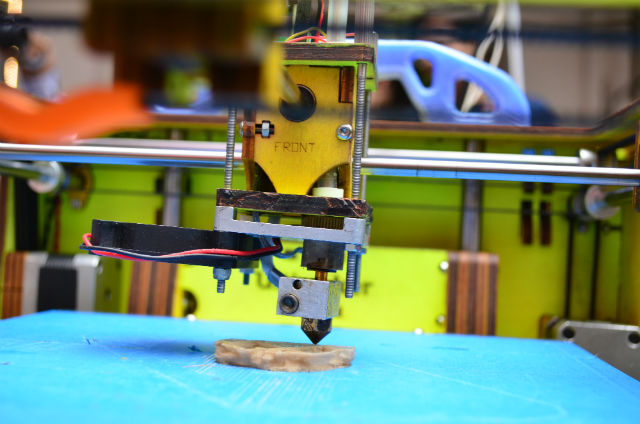<h2 style="text-align: justify">3D Printing in 2014 and Beyond</h2>
<p style="text-align: justify">There has been no shortage of rhapsodizing about the wonders of 3D printing. And to the uninitiated, the technology does sound like something out of a science fiction novel. But 3D printing isn&#8217;t particularly futuristic or mind-bending &#8212; it&#8217;s actually rather straightforward. Essentially, 3D printers are machines that can make a variety of objects from different source materials, like plastic. They can manufacture things such as toys, furniture or even food. While 3D printing is still in its infancy, the potential ramifications are astounding.</p>
<p style="text-align: justify">&#8220;3D printers will replace traditional factory manufacturing in some circumstances,&#8221; said Scottsdale Arizona entrepreneur Jason Hope. &#8220;You can dream up a product, then print it. The technology isn&#8217;t quite refined enough for the home user, but that&#8217;s only a short time away. This is a product that&#8217;s been burdened with tremendous hype, but this technology is potentially transformative.&#8221;</p>
<p style="text-align: justify">Let&#8217;s take a look at where 3D technology is heading in 2014 and beyond.</p>
<h2 style="text-align: justify"><strong>Printing in the Home</strong></h2>
<p style="text-align: justify">While 3D printers are reasonably common in schools and workshops, they aren&#8217;t quite a standard home use product yet. Perhaps the biggest hurdle is user experience. 3D printers aren&#8217;t exceedingly difficult to use, but they aren&#8217;t &#8220;pull it out of the box and press a button&#8221; easy, either. They have to be maintained, and adjustments must be made on occasion. Anyone who has ever had a negative home or office experience with a standard printer probably cringes at the thought of battling with a space age, futuristic version of the same device. But those fears are misguided &#8212; the technology is becoming more reliable and refined all the time, and the user experience is improving rapidly.</p>
<p style="text-align: justify">Cost isn&#8217;t prohibitive either. Basic models can be had for less than $500, and that price is expected to drop significantly in years to come. Those who don&#8217;t wish to invest in a home printer will likely be able to take advantage of 3D printing at the retail level, much like it&#8217;s possible to make copies of paper documents at stores today.</p>
<h2 style="text-align: justify"><strong>The Shape of Things to Come</strong></h2>
<p style="text-align: justify">One complaint often leveled at basic 3D printing is the lack of different source materials. Right now, plastic is commonly used at the sub-professional level. That limits creators&#8217; options, but new printers capable of working with new building materials will be introduced at the commercial level in the years ahead. Once the technology matures, home printers will become far more powerful.</p>
<p style="text-align: justify">If we have a favorite object that suddenly breaks, it will be possible to immediately re-print that lost object. Instead of dealing with items that are sold out at stores, those items can simply be ordered, then printed on demand, fit to each person&#8217;s custom specifications. Everything we use on a daily basis &#8211; tools, furniture, clothes etc. &#8211; will be custom designed and tailored to fit our precise size. The rise of personal manufacturing will allow people to start their own enterprises with minimal capital, freeing them to take risks they might ordinarily avoid. This will lead to greater innovation and creativity, and potentially transform the way the world does business.</p>
<p style="text-align: justify">Not all of printing applications will be commercial, however. The technology is already having a cultural impact, as artists use 3D printing to create new works, or incorporate the technology with existing art forms.</p>
<p style="text-align: justify">Medicine, too, will see a dramatic shift. Chinese scientists are already printing organs that remain functional for months at a time, and it&#8217;s likely only a matter of time before the printing of limbs and organs is commonplace &#8212; a medical breakthrough that would save countless lives and revolutionize the entire industry.</p>
<p style="text-align: justify">It seems hard for many to believe these kind of dramatic changes are happening already, and will only accelerate in the years ahead. But it was equally hard to envision the eventual impact of the Internet 25 years ago, or the rise of social media a decade later. 3D printing has the potential to radically reshape society at a fundamental level. Once the technology matures and is refined for the consumer market, today&#8217;s miracle will become tomorrow&#8217;s everyday occurrence.</p>
<p style="text-align: justify">About Author: Amy Taylor is a technology and business writer. Amy began her career as a small business owner in Phoenix, Arizona. She has taken that knowledge and experience and brought that to her unique writing capabilities. She really enjoys new business related issues that are tied directly to technology.</p>

3D Printing In 2014 And Beyond
